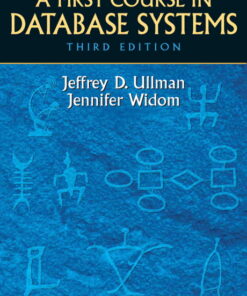Solution Manual for Analysis of Economic Data, 4th Edition, Gary Koop, ISBN: 978-1-118-47253-8, ISBN-10: 1118472535, ISBN-13: 9781118472538
$55.00
Solution Manual for Analysis of Economic Data, 4th Edition, Gary Koop, ISBN: 978-1-118-47253-8, ISBN-10: 1118472535, ISBN-13: 9781118472538
Downloadable Solution Manual for Analysis of Economic Data, 4th Edition, Gary Koop, ISBN: 978-1-118-47253-8, ISBN-10: 1118472535, ISBN-13: 9781118472538
This is not an original TEXT BOOK (or Test Bank or original eBook). You are buying Solution Manual. A Solution Manual is step by step solutions of end of chapter questions in the text book. Solution manual offers the complete detailed answers to every question in textbook at the end of chapter. Please download sample for your confidential. All orders are safe, secure and confidential.
Table of Contents
Chapter 1 Introduction 1
Organization of the Book 3
Useful Background 4
Appendix 1.1: Mathematical Concepts Used in this Book 4
Endnote 7
References 7
Chapter 2 Basic Data Handling 8
Types of Economic Data 8
Obtaining Data 13
Working with Data: Graphical Methods 15
Working with Data: Descriptive Statistics 20
Appendix 2.1: Index Numbers 23
Appendix 2.2: Advanced Descriptive Statistics 28
Appendix 2.3: Expected Values and Variances 30
Endnotes 32
Chapter 3 Correlation 34
Understanding Correlation 34
Understanding Why Variables Are Correlated 38
Understanding Correlation Through XY-Plots 41
Correlation Between Several Variables 45
Appendix 3.1: Mathematical Details 46
Endnotes 46
Chapter 4 Introduction to Simple Regression 48
Regression as a Best Fitting Line 48
Interpreting OLS Estimates 53
Fitted Values and R2: Measuring the Fit of a Regression Model 56
Nonlinearity in Regression 60
Appendix 4.1: Mathematical Details 64
Endnotes 66
Chapter 5 Statistical Aspects of Regression 67
Which Factors Affect the Accuracy of the Estimate ߈ ? 68
Calculating a Confidence Interval for ß 72
Testing whether ß = 0 78
Hypothesis Testing Involving R2: The F-Statistic 82
Appendix 5.1: Using Statistical Tables to Test Whether ß = 0 85
Endnotes 87
References 88
Chapter 6 Multiple Regression 89
Regression as a Best Fitting Line 91
OLS Estimation of the Multiple Regression Model 91
Statistical Aspects of Multiple Regression 91
Interpreting OLS Estimates 92
Pitfalls of Using Simple Regression in a Multiple Regression Context 95
Omitted Variables Bias 97
Multicollinearity 99
Appendix 6.1: Mathematical Interpretation of Regression Coefficients 105
Endnotes 105
Chapter 7 Regression with Dummy Variables 107
Simple Regression with a Dummy Variable 109
Multiple Regression with Dummy Variables 110
Multiple Regression with Dummy and Non-dummy Explanatory Variables 113
Interacting Dummy and Non-dummy Variables 116
Chapter 8 Qualitative Choice Models 119
The Economics of Choice 120
Choice Probabilities and the Logit and Probit Models 121
Appendix 8.1: Choice Probabilities in the Logit Model 128
References 130
Chapter 9 Regression with Time Lags: Distributed Lag Models 131
Lagged Variables 133
Notation 135
Selection of Lag Order 138
Appendix 9.1: Other Distributed Lag Models 141
Endnotes 143
Chapter 10 Univariate Time Series Analysis 144
The Autocorrelation Function 147
The Autoregressive Model for Univariate Time Series 151
Nonstationary versus Stationary Time Series 154
Extensions of the AR(1) Model 156
Testing in the AR(p) with Deterministic Trend Model 161
Appendix 10.1: Mathematical Intuition for the AR(1) Model 166
Endnotes 167
References 168
Chapter 11 Regression with Time Series Variables 169
Time Series Regression when X and Y Are Stationary 170
Time Series Regression when Y and X Have Unit Roots: Spurious Regression 174
Time Series Regression when Y and X Have Unit Roots: Cointegration 174
Estimation and Testing with Cointegrated Variables 177
Time Series Regression when Y and X Are Cointegrated: The Error Correction Model 181
Time Series Regression when Y and X Have Unit Roots but Are Not Cointegrated 184
Endnotes 187
Chapter 12 Applications of Time Series Methods in Macroeconomics and Finance 189
Financial Volatility 190
Autoregressive Conditional Heteroskedasticity (ARCH) 196
Granger Causality 200
Vector Autoregressions 206
Appendix 12.1: Hypothesis Tests Involving More than One Coefficient 221
Endnotes 225
Reference 226
Chapter 13 Limitations and Extensions 227
Problems that Occur when the Dependent Variable Has Particular Forms 228
Problems that Occur when the Errors Have Particular Forms 229
Problems that Call for the Use of Multiple Equation Models 231
Endnotes 236
Appendix A Writing an Empirical Project 237
Description of a Typical Empirical Project 237
General Considerations 239
Project Topics 240
References 244
Appendix B Data Directory 246
Author Index 249
Subject Index 250
Be the first to review “Solution Manual for Analysis of Economic Data, 4th Edition, Gary Koop, ISBN: 978-1-118-47253-8, ISBN-10: 1118472535, ISBN-13: 9781118472538” Cancel reply
Related products
Solution Manual
Solution Manual
American History Connecting with the Past 15th Edition Alan Brinkley Solutions Manual












Reviews
There are no reviews yet.